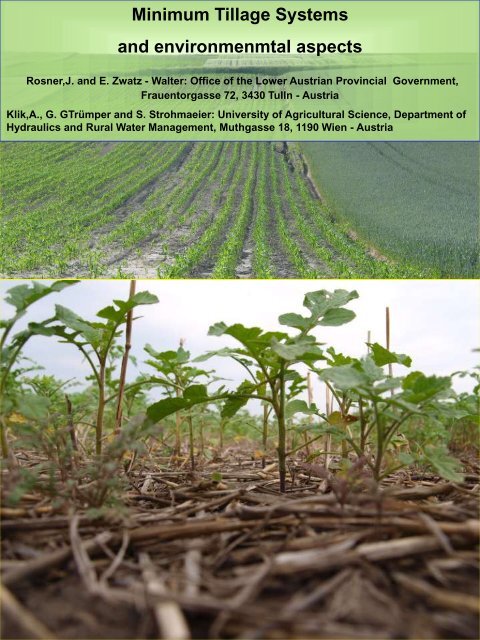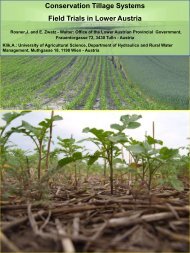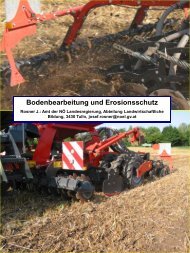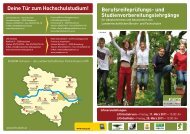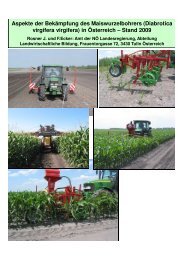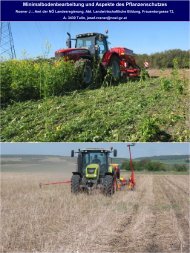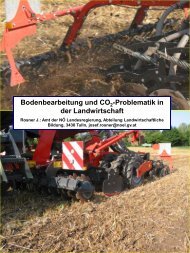Minimum Tillage Systems and environmenmtal aspects
Conventional tillage - Land-Impulse
Conventional tillage - Land-Impulse
Create successful ePaper yourself
Turn your PDF publications into a flip-book with our unique Google optimized e-Paper software.
<strong>Minimum</strong> <strong>Tillage</strong> <strong>Systems</strong><br />
<strong>and</strong> <strong>environmenmtal</strong> <strong>aspects</strong><br />
Rosner,J. <strong>and</strong> E. Zwatz - Walter: Office of the Lower Austrian Provincial Government,<br />
Frauentorgasse 72, 3430 Tulln - Austria<br />
Klik,A., G. GTrümper <strong>and</strong> S. Strohmaeier: University of Agricultural Science, Department of<br />
Hydraulics <strong>and</strong> Rural Water Management, Muthgasse 18, 1190 Wien - Austria
Interrillerosion<br />
Perched water<br />
table<br />
in the depression
Tullnerfeld – Gollarn 2009
Direct drilling erosion control
SOLUTION <br />
Direct drilling without disc harrow in front of seeder<br />
No till drill into straw of winter wheat<br />
Yellow mustard + California bluebell – Phacelia as cover crops
10 th August 2010 Mr.Zaussinger- NoTill farmer for 11 years
Conventional tillage - neighbour<br />
29th August 2011 NoTill farm Zaussinger Lower Austria<br />
Lineseed + yellow mustard + oil radish + vetchling
Flowering vetchling
NoTill<br />
demonstration field<br />
Hollabrunn<br />
Lower Austroa<br />
Pioneer crop: : 2009 corn – disc harrow → Winterbarley - Mulchseed<br />
with Kuhn Speedliner September 2009<br />
Cover crop seeding July 29 th 2010 NoTill
Cover crops 2010 seed time 29 th July - NoTill
Cover crops 27 th September 2010 seed time 29th July
Nodule bacteria
70 t organic matter per ha<br />
November 2010<br />
27. September 2010
Corn planting<br />
April 2011<br />
Organic<br />
matter<br />
winds<br />
around<br />
the rotary<br />
clod<br />
breakers
Complete corn emergence
29th August 2011
Conventional tillage: same variety, same plant protection <strong>and</strong><br />
fertilizers<br />
shorter growing period
NoTill corn, drilled with Cross Slot
NoTill sugarbeet Lower Austria 2007
NoTill sugar beet 30 th August 2011
NoTill pumpkins
Per ha in the soil:<br />
25 t flora<br />
5 t fauna<br />
<br />
Corresponding<br />
6 livestock units
Johann Peck Andau<br />
NoTill
Cionventional<br />
tillage with plow<br />
NoTill
International tendencies in<br />
<strong>Tillage</strong><br />
•1989.............. 10 Mio ha No Till<br />
•2001............ 65 Mio. ha No Till<br />
•2002............ 68 Mio. ha No Till<br />
•2004............ 72 Mio. ha No Till<br />
•2006………. 90 Mio. ha No Till<br />
•2012……….>117 Mio. ha No Till<br />
•Countries:<br />
USA (25 Mio. ha), Canada (12 Mio. ha), Brasil,<br />
Argentina – Latin America > 60 Mio. ha,<br />
Australia (> 10 Mio. ha)<br />
More than 98 % of the No Till l<strong>and</strong> in these<br />
countries
Reasons for No Till<br />
•Lowering of production cost<br />
•Fewer passes – less work time less soil<br />
compaction<br />
•Increased productivity – cultivation of larger<br />
area possible<br />
•Reduction of fuel consumption<br />
( 250 l < 80 l/ha )<br />
•Lower machine use<br />
•Prevention of wind – water – tillage erosion<br />
•Increased humus content<br />
•Improved water retention<br />
•Better yield<br />
•Lower carbon dioxide release from the soil<br />
climate – <strong>and</strong> soil alliances
Field demonstration Lower Austria August 4 th 2009<br />
500 participants
Field demonstration Hollabrunn 2010
Field demonstration Seitenstetten<br />
August 17th 2011<br />
John Deere 750
Self made seed drill
NoTill Soybean in cornstraw Argentina 2010
NoTill corn<br />
Argentina 2010
occurrence<br />
F. Graminearum 30%<br />
F. Avenaceum 14%<br />
F. Poa 12%<br />
F. Tricinctum 2%<br />
F. Sporotrichoides < 1%<br />
F.Subglutinans 22%<br />
F. Proliferatum 12%<br />
F. Equiseti 1%<br />
Dry Rot<br />
Fusarium Sp.<br />
Conidiospores<br />
spread by<br />
raindrops <strong>and</strong><br />
wind<br />
Reproduction<br />
without<br />
symptoms<br />
Ascosores<br />
windspread<br />
Stubbles corn with<br />
Perithecies
volunteer barley Risk of barley yellow dwarf virus
Cover crop roller developed <strong>and</strong> constructed in Lower<br />
Austria (Hahnekamp, Rosner)<br />
instead of shredding lower fuel consumption <strong>and</strong> more capacity<br />
Roller to squeeze cover crops in fall → reduction of water<br />
consumption
Soil erosion measurement sites Austria<br />
Pyhra<br />
N = 883mm, T = 8,6°C<br />
Pixendorf<br />
N = 768mm, T = 9,5°C<br />
N = 686mm, T = 8,1°
Sample divider<br />
Sedimentcollector<br />
3 % sampled – divided by tubes
Losses in differnet tillage practise<br />
1994 - 2011<br />
Klik et.al<br />
University of Agricultural Science Vienna<br />
Conventional<br />
<strong>Tillage</strong> mulchseed Direct drilling<br />
Soil loss t/ha 9.4 2.3 1.2<br />
reduction 75% 87%<br />
Corg - loss kg/ha 100.5 32.7 17.1<br />
reduction 67% 82%<br />
N - loss kg/ha 14.0 6.9 3.8<br />
reduction 51% 73%<br />
P - loss kg/ha 7.0 1.9 0.9<br />
reduction 73% 87%<br />
runoff in mm 25.3 21.9 18.0<br />
Herbicide loss<br />
% sprayed 2.20% 1.01% 0.6%<br />
reduction 55% 74%<br />
Herbicide loss<br />
im runoff 1,73% 0,87% 0,17%<br />
reduction 50% 90%<br />
Herbicide loss<br />
In sediment 3.09% 1.16% 1.99%<br />
reduction 62% 36%
Soil Loss water Erosion 1994 - 2011<br />
1,1<br />
Direct drillng - No<strong>Tillage</strong><br />
2,4<br />
Pixendorf(Tulln)<br />
Mistelbach<br />
<strong>Minimum</strong> tillage -<br />
Mulchseed<br />
3,5<br />
3,8<br />
14,3<br />
Conventional<br />
26<br />
0 10 20 30
Carbon Losses kg/ha/Year<br />
14<br />
Direct drillng - No<strong>Tillage</strong><br />
Direct seeding<br />
33<br />
18<br />
Pixendorf(Tulln)<br />
Mistelbach<br />
49<br />
Mulchseed<br />
<strong>Minimum</strong> tillage - Mulchseed<br />
49<br />
Conventional<br />
Seed<br />
132<br />
100,5<br />
Conventional<br />
0 20 40 60 291 80 100<br />
Organic Carbon Losst Corg kg/ha/year<br />
0 50 100 150 200 250 300
Runnof mm 2007<br />
Abfluss mm Tulln - Pixendorf 2007<br />
Kultur Körnermais<br />
erosion trial Tullnerfeld<br />
Directseedingt<br />
5<br />
runnoff mm 2007<br />
Mulchseest<br />
47<br />
conventional<br />
109<br />
0 20 40 60 80 100 120<br />
runnoff mm pro ha
unnoff mm/year<br />
26<br />
Direct drillng - No<strong>Tillage</strong><br />
6<br />
Pixendorf(Tulln) 2011 corn<br />
Mistelbach 2010 corn<br />
29<br />
<strong>Minimum</strong> tillage - Mulchseed<br />
19<br />
58<br />
Conventional<br />
19<br />
0 20 40 60
•Worldwide loss of 10 million ha arable<br />
l<strong>and</strong> by soil erosion<br />
•0.1 – 1 mm erosion per year<br />
tolerable……15 t/ha/year…..0.01 – 40<br />
mm in practice occure<br />
•Soil regeneration in Central Europe<br />
1t/ha/year<br />
•In Western Germany 20 – 50 mm soil<br />
layer eroded in the last 50 years yield<br />
reduction 10 – 20 %<br />
•World online January 24th 2011:<br />
millenium tool plow to the scrap metal
Yield in relative % 1994 – 2011 Mistelbach-<br />
Pyhra(St.Pölten)-Pixendorf(Tulln)<br />
Rosner, Zwatz, Bartmann, Spieß<br />
<strong>Tillage</strong> method/ Yield kg<br />
per ha<br />
Mistelbach Pyhra Pixendorf<br />
Conventional<br />
Cultivator – plow<br />
No cover crop<br />
100 100 100<br />
Cultivator – Mulchseed –<br />
Cover Crop: yellow<br />
mustard, california<br />
bluebell, buckwheat, red<br />
clover, oil radish<br />
Cultivator – direct<br />
drilling<br />
Cover crop : 7 kg/ha<br />
California Bluebell, 3 kg/ha<br />
Yellow Mustard<br />
96 103 102<br />
90 111 105<br />
Cultivator – direct<br />
drilling<br />
89<br />
105<br />
96<br />
cover crop : 80 kg/ha<br />
winter rye<br />
Cultivator – direct<br />
drilling<br />
Cover crop :120 kg/ha<br />
summer barley<br />
97<br />
110<br />
112
CO2 – emission from soil respiration mesurement period 2007 - 2009<br />
(Trümper G. u. A.Klik)<br />
45<br />
40<br />
CO2-Freisetzung t/ha/Jahr<br />
t CO 2 /ha/a<br />
41,8<br />
Pixendorf<br />
TULLN<br />
37,3<br />
CT RT NT<br />
35<br />
32,5<br />
30<br />
30,6<br />
29,8<br />
27,9<br />
25<br />
24,8<br />
23,9<br />
24,9<br />
22,9<br />
24,1 23,8<br />
18,7<br />
21,6<br />
20<br />
17,5<br />
16,8<br />
18,6<br />
15<br />
14,7<br />
10<br />
5<br />
0<br />
2007 KM 2008 WW 2009 KM 2007 WiRaps 2008 WW 2009 SG<br />
2007 2008 2009<br />
Average Jahresmitteltemperatur temperature year (°C) 11,2 11,5 10,4<br />
Jahresniederschlag Annual rainfall (mm) 674,1 710,7 906,4
CO2-C-Freisetzung 2008<br />
(t ha -1 )<br />
CO2-C-Freisetzung 2007<br />
(t ha -1 )<br />
10<br />
8<br />
MW<br />
6<br />
4<br />
2<br />
0<br />
CT RT NT CT RT NT<br />
Pixendorf<br />
Tulln<br />
CO2 – C – respiration measurement period April – November<br />
2007 (up) <strong>and</strong> 2008 (down) with minimum – average – maximum<br />
value Tullnerfeld – Danube valley (Klik <strong>and</strong> Trümper)<br />
10<br />
8<br />
MW<br />
6<br />
4<br />
2<br />
0<br />
CT RT NT CT RT NT<br />
Pixendorf<br />
Tulln
Methane, lauging gas <strong>and</strong> Carbon doixide flux in<br />
closed chamber - non-steady-state through-flow<br />
chamber - June 9th 2008 Pixendorf (Klik et al.)<br />
150<br />
125<br />
115<br />
126<br />
140<br />
Biomass-C (mg 100 g -1 DM -1<br />
F CH4 ; F N2O (mg m -2 h -1 )<br />
F CO2 (g m -2 h -1 )<br />
1,0<br />
0,8<br />
0,74<br />
1,0<br />
0,8<br />
0,6<br />
0,4<br />
0,2<br />
0,0<br />
-0,015<br />
-0,024<br />
-0,022<br />
0,19<br />
0,17<br />
0,23<br />
0,43<br />
0,36<br />
0,6<br />
0,4<br />
0,2<br />
0,0<br />
-0,2<br />
Methane N 2 O nitrous oxide CO 2<br />
CT RT NT<br />
-0,2<br />
Biomass C mg/100g<br />
CT RT NT<br />
100<br />
92<br />
93<br />
91<br />
97<br />
75<br />
62<br />
59<br />
67 67<br />
62<br />
54<br />
74 72<br />
50<br />
25<br />
0<br />
Kirchberg Mistelbach Pixendorf Pyhra Tulln<br />
Microbial Biomass ( mg Biomass-C 100 g-1 dry matter-1 (DM) (Klik et al.)
Organic Carbon t/ha in soil 0 – 30 cm<br />
(Trümper G. u. A.Klik)<br />
Corg_0-30 cm (t ha -1 )<br />
100<br />
90<br />
80<br />
70<br />
60<br />
50<br />
40<br />
30<br />
20<br />
10<br />
0<br />
89,2 89,6<br />
CT RT NT<br />
74,5<br />
77,1<br />
66,3<br />
65,1 66,8<br />
60,4 62,8<br />
Pixendorf Tulln Kirchberg am Walde<br />
CT
% SAS<br />
Pixendorf – Danube valley<br />
Aggregatte stability<br />
30,00<br />
25,00<br />
20,00<br />
15,00<br />
10,00<br />
5,00<br />
0,00<br />
Conventional tillagell mulchseed NoTill<br />
Aggregate stability (SAS) Pixendorf - Tullnerfeld<br />
n = 9<br />
Better load carrying capacity of the soil<br />
less soil compaction with traffic, no<br />
plowpan better water infiltration<br />
during storm events…….
Results <strong>Tillage</strong> trials Lower Austria 1999 - 2010<br />
<strong>Tillage</strong> method Yield %<br />
conventional<br />
Net profit<br />
Conventional <strong>Tillage</strong><br />
Cultivator-Plow-<br />
Seedbedpreparation<br />
Reduced - Chisel Plow<br />
2 x<br />
<strong>Minimum</strong> <strong>Tillage</strong> (Disc<br />
Harrow 1x)<br />
100 100<br />
99 109<br />
98 113<br />
No Till NT 90 113<br />
no till<br />
90<br />
113<br />
minimum tillage<br />
98<br />
113<br />
net profit<br />
reduced tillage<br />
99<br />
109<br />
yield %<br />
conventional<br />
conventional tillage<br />
100<br />
100<br />
0 20 40 60 80 100 120
Tests of CO 2 emission by cultivation#<br />
Clay soil Tulln 2008<br />
CT RT NT<br />
Fuel consumption(l/ha) 57 28 6,2<br />
Working time(min/ha) 125,5 57 15<br />
CO 2 Emissionfactor 3,15:<br />
70,00<br />
60,00<br />
180,76 kg CO 2 /ha 89,36 kg CO 2 /ha 19,50 kg CO 2 /ha<br />
seeding(rotary cultivator+seed drill 3 m)<br />
CT und RT; NT:Väderstad 3 m)<br />
50,00<br />
40,00<br />
19,46<br />
Plow 4 plowshare, 1,52<br />
m)<br />
Disc harrow (3 m)<br />
30,00<br />
20,00<br />
32,19<br />
23,78<br />
10,00<br />
0,00<br />
5,74<br />
4,59<br />
6,19<br />
CT RT NT
fuel consumption <strong>and</strong> CO 2 -emission kg/ha 2008 - 2010<br />
140<br />
139<br />
120<br />
100<br />
fuel consumption<br />
carbon emission<br />
80<br />
60<br />
63<br />
44<br />
40<br />
20<br />
20<br />
22<br />
7<br />
0<br />
conventional<br />
cultivator -<br />
plow<br />
reduced tillage<br />
- cultivator -<br />
mulchseed<br />
No <strong>Tillage</strong> -<br />
direct seeding
Conclusion<br />
•Mulch –<strong>and</strong> direct –seeding systems are fully developed <strong>and</strong><br />
go well in practice.<br />
•The economical benefits must not ignore the nutrient –<br />
pesticide <strong>and</strong> soil movement (erosion).<br />
•Cereal – maize crop rotation needs a shallow mulch of crop<br />
residuals for a fast decomposition as a phytosanitary need<br />
(Fusarium Mycotoxines)<br />
•After harvest the growth of volunteer cereals has to be<br />
interrupted, they st<strong>and</strong> for a green bridge for plant diseases<br />
like barley yellow dwarf virus or Fusarium sp. <strong>and</strong> pests like<br />
aphids as a vector for the virus.<br />
•An immediately seeding of cover crops after harvest for a<br />
good development of the green manure.<br />
•Reduction of soil erosion is a requirement <strong>and</strong> possible<br />
•Reduction of CO 2 – emission is significant<br />
•Increase of microbial biomass<br />
•Increase of organic Carbon in the soil<br />
•A reduction of the costs is possible <strong>and</strong> necessary.<br />
•A prescription is not possible <strong>and</strong> depends from the crop<br />
rotation <strong>and</strong> natural situation.
“Es ist nicht die kräftigere Art die<br />
überlebt, auch nicht die<br />
intelligenteste, sondern die, die am<br />
schnellsten auf Änderungen<br />
reagiert”<br />
Charles Darwin<br />
It is not the strongest<br />
species which survives,<br />
also not the most<br />
intelligemt one, but that<br />
which reacts fastest to<br />
changes.


